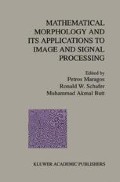Abstract
The present paper provides a brief overview of the optimization and adaptive theories of reconstructive binary granulometric filters. When the generating sets of a Euclidean granulometry are compact and convex, the granulometry represents a parameterized family of-openings, each being a union of openings with structuring elements scalar multiplied by t > 0. The concept is generalized to a multivariate granulometry by allowing each structuring element to be parameterized by a vector, thereby generating a family of-openings parameterized by the vectors. Each such multivariate granulometry induces a reconstructive multivariate granulometry defined by passing each connected component of an image that is not eliminated by the original granulometry and not passing each connected component that is fully eliminated. Given ideal and observed (corrupted) random sets, the optimization problem for image restoration by multivariate reconstructive gran-ulometries is find to a value of the parameter vector that minimizes the expected error (expected symmetric-difference area) between the ideal and the filtered observation. The corresponding adaptive filter problem is to allow the parameter vector to transition during a scanning process in such a way as to produce desired results and to study the steady-state properties of the multi-dimensional Markov chain defined by the state space of the now random parameter vector. A second approach to granulometric filtering is to decompose an image by means of the spectral components produced by the granulometry and then pass some subfamily of the spectral components. Given ideal and observed image processes, the optimization for these bandpass filters is to pass spectral components in a manner that minimizes restoration error. One can also proceed adaptively by allowing the parameters defining the passbands to adapt, thereby producing a multi-dimensional state space for a Markov chain whose steady-state properties characterize adaptivity. These four optimization and adaptation problems are discussed in the present paper, with emphasis how they yield filters for restoration in the signal-union-noise model.
Access this chapter
Tax calculation will be finalised at checkout
Purchases are for personal use only
Preview
Unable to display preview. Download preview PDF.
References
Batman, S., Dougherty, E. R., Rzadka, M., and J. Chapa, “Multivariate Morphological Granulometric Texture Classification using Walsh and Wavelet Features,” Proc. SPIE Visual Information Processing, Vol. 2488, Orlando, April, 1995.
Dougherty, E. R., “Filtering Clutter by Optimal Granulometric Bandpass Filters,” Proc. SPIE Visual Information Processing, Vol. 2488, Orlando, April, 1995.
Matheron, G., Random Sets and Integral Geometry, John Wiley, New York, 1975.
Dougherty, E. R., and C. Cuciurean-Zapan, “Optimal Reconstructive-Openings for Disjoint and Statistically Modeled Nondisjoint Grains,” (submitted).
Dougherty, E. R., Haralick, R. M., Chen, Y., Agerskov, C., Jacobi, U., and P. H. Sloth, “Estimation of Optimal-Opening Parameters Based on Independent Observation of Signal and Noise Pattern Spectra,” Signal Processing, Vol. 29, 1992.
Meyer, R., and Beucher, S., “Morphological Segmentation,” Visual Communication and Image Representation, Vol. 1, No. 1, 1990.
Chen, Y., and E. R. Dougherty, “Adaptive Reconstructive Multiparameter -Openings,” (submitted).
Jackson, J. R., “Networks of Waiting Lines,” Operational Research, Vol. 10, No. 1, 1963.
Chen, Y., and E. R. Dougherty, “Adaptive Reconstructive -Openings: Convergence and the Steady-State Distribution,” (submitted).
Dougherty, E. R., “Optimal Binary Morphological Bandpass Filters Induced by Granulometric Spectral Representation,” to appear in Mathematical Imaging and Vision.
Haralick, R. M., Katz, P. L., and E. R. Dougherty, “Model-Based Morphology: The Opening Spectrum,” CVGIP: Graphical Models and Image Processing, Vol. 57, No. 1, 1995.
Chen, Y., “Convergence of Adaptive Morphological Filters in the Context of Markov Chains,” Ph.D. Thesis, Rochester Institute of Technology, Rochester, NY, 1995.
Author information
Authors and Affiliations
Editor information
Editors and Affiliations
Rights and permissions
Copyright information
© 1996 Kluwer Academic Publishers
About this chapter
Cite this chapter
Dougherty, E.R., Chen, Y. (1996). Optimal and Adaptive Design of Reconstructive Granulometric Filters. In: Maragos, P., Schafer, R.W., Butt, M.A. (eds) Mathematical Morphology and its Applications to Image and Signal Processing. Computational Imaging and Vision, vol 5. Springer, Boston, MA. https://doi.org/10.1007/978-1-4613-0469-2_29
Download citation
DOI: https://doi.org/10.1007/978-1-4613-0469-2_29
Publisher Name: Springer, Boston, MA
Print ISBN: 978-1-4613-8063-4
Online ISBN: 978-1-4613-0469-2
eBook Packages: Springer Book Archive

